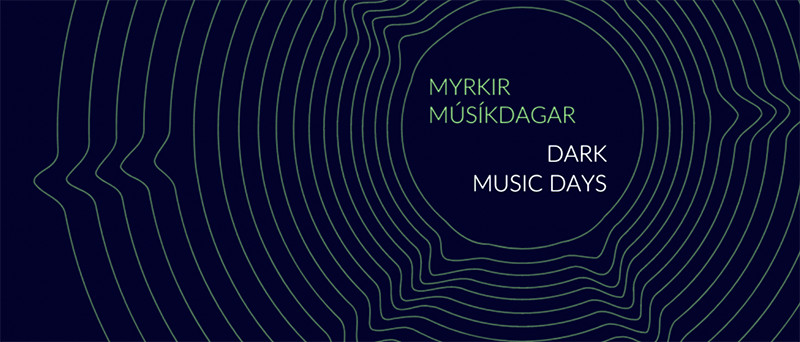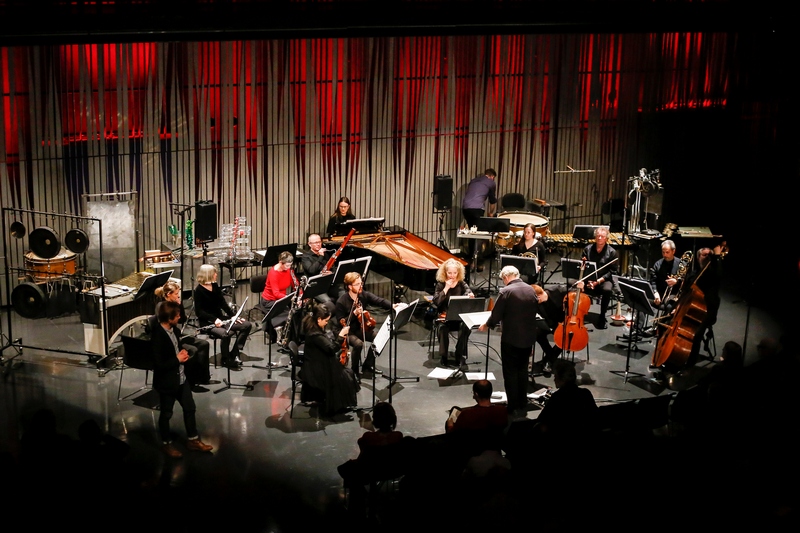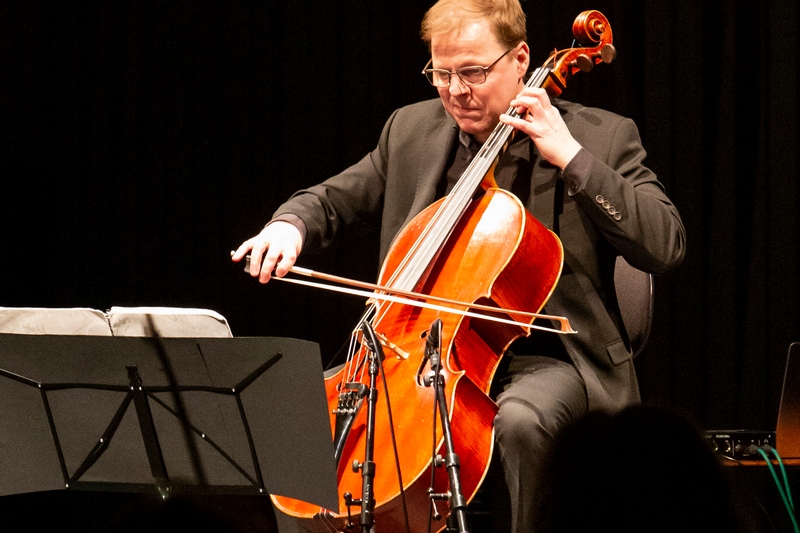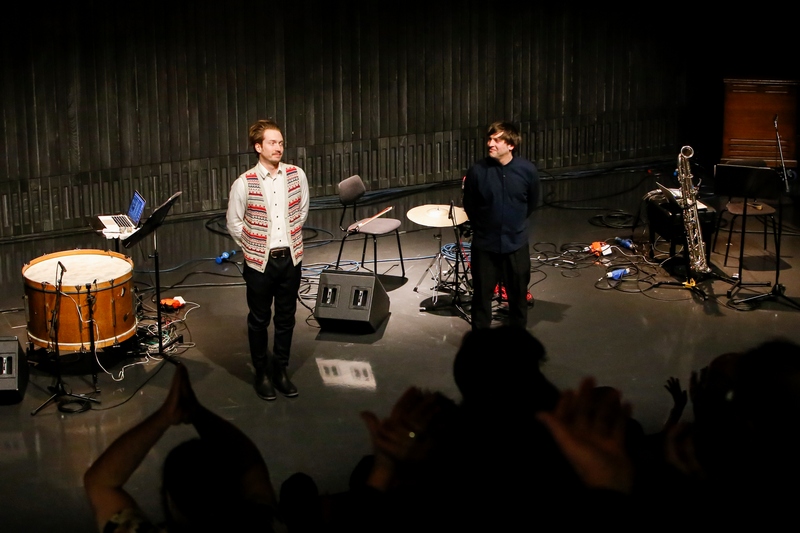
As i mentioned previously, the majority of the music i heard at this year’s Dark Music Days fell somewhere between emotional allusion and full-on abstraction. In many ways it was the most abstract music that made some of the strongest and most long-lasting impressions, primarily because of the composers’ focus on music as music and sound as sound, devoid of either theatrics or direct, tangible references.
The long evening concert given by Caput Ensemble, conducted by Guðni Franzson, featured many striking examples of this. Haukur Tómasson’s Flux 173 demonstrated the composer’s usual predilection for breathless rhythmic material, though here everything trembled as if the players were palpitating. From this the music passed through a highly dynamic energy contour, sometimes attaining real power in stunning full force tuttis, occasionally veering off into lyrical territory, unexpectedly petering out (albeit at volume) before soaring over deep drones. Even more exhilarating was Þan by Kristján Guðjónsson, the title of which means “expansion”. From the outset we heard multiple concentric layers moving at different speeds, some fast (arpeggiating), some slow (melodic). When the music thinned, it revealed canons whirling at its heart, like cogs balletically turning in a machine. This reinforced the overall impression of Þan acting like an elaborate clockwork mechanism, in which a process worked itself out, along the way splitting into two separate but sympathetic sub-systems. It’s worth nothing that, in contrast to a great deal of what’s performed in contemporary music festivals these days, this was a piece that didn’t use anything even approaching what might be called an extended technique – yet nothing about Þan sounded remotely conservative or ‘safe’: on the contrary, it was riveting, disorienting and ravishing in equal measure.

A complete contrast in terms of levels of complexity and energy was Haukur Þór Harðarson’s Coda, a superb 17-minute exercise in vague, elusive delicacy. The members of Caput worked as one in each of the work’s episodes, at times sounds as if their combined actions approximated a kind of communal breathing in and out. It soon became apparent that watching the players greatly limited one’s perception of the huge quantity of tiny details within the music. These details emerged from the fact that the sustained tones comprising the basic palette of Coda’s material almost always exhibited some kind of internal interest and (dynamic / pitch / timbral) change, resulting in a behavioural stasis in which absolutely nothing was ever truly static.
In an otherwise rather disappointing recital from Aulos Flute Ensemble, Agnes Ida Pettersen’s Trio featured an interestingly polarised form of melody and accompaniment, the latter typified by buzzes, growls and distorted low notes, the work’s slow pace making them sound all the more nicely grotesque. In the same concert, Corridors of light II by Japanese composer Mari Takano was outstanding. Its constant stream of highly florid counterpoint raised questions as to whether the three flute parts were related, tangentially connected or just simply adjacent, an ambiguity that only became resolved towards the work’s conclusion. The highlight of the Reykjavík Chamber Orchestra’s concert turned out to be the shortest work on the programme, Elín Gunnlaugsdóttir’s Skuggi handa ϸinna [“shadow of your hands”], receiving its world première. There was something Berg-like about its harmonic fluidity, though Elín occasionally focused this by allowing it to rest briefly in particular tonal configurations. Throughout there was a sense of the players congregating around a main melodic idea / direction, yet continually spiralling off and away only to be pulled back in due course. It created a wonderful simultaneous sense of unity and individuality, all of which overflowed with lyricism.
Cellist Sigurgeir Agnarsson brought together music by two generations of Icelandic composers. Now 81 years old, Hafliði Hallgrímsson had returned to his roots in his new work Solitaire II, a piece that effectively picked up where his opus 1, Solitaire I, had ended back in 1970. Performed at the start and end of the recital respectively, both works featured a tendency to set up situations where melodies could rise freely while never losing their connection to the firmament, grounded in low register pizzicatos and double stops. Solitaire II featured precisely the same mix of introspection and energy as its predecessor (impressive that a composer could so effortlessly step back into the mindsight of music composed half a century earlier), heard to best effect in the third movement ‘Intersessio’, combining solemnity with ethereal tremolando harmonics.
It was curious to hear Hugi Guðmundsson’s music exhibit a similarly grounded quality. This was especially effective in Veris for cello and electronics, where there was the impression of something akin to a bird scarer, flapping wildly while tethered to the ground. Initially the electronics, repeating loops of the cello’s free-flowing material, acted to tether the instrument, but later the roles were reversed, Hugi allowing the electronics to fly as a soft, pulsating loop cloud while Sigurgeir’s cello adopted an almost Tudor-like demeanour, serious and sombre.
Some of the best examples of abstract and conceptual sound exploration came from Davíð Brynjar Franzson. His Violin Fragments, given its first performance by Nordic Affect on the opening night of the festival, operated at something of a distance, filling the space with the sounds of urban noise while Halla Steinunn Stefánsdóttir slowly walked around the outside of the audience (arranged in the round), picking out sounds and tones on her violin in response to this recorded ambience. The faintness and ambiguity of the music – which, throughout, was at a very low level – only made it more intriguing and sent the mind and ears into overdrive attempting to parse the nature of the connection between live and prerecorded sounds.
More sonically pressing were three versions of Davíð Brynjar’s The Cartography of Time, combining electronics with, respectively, bowed cymbal, contrabass clarinet and bass drum. All three versions gently coaxed short-lived vibrations from their instruments – a bow on the cymbal; breath through the clarinet; a hand and superball mallet on the drumhead – which were fed into the electronics that transformed these minimal stimuli into an extended, expanded soundworld. Laden with ever-changing overtones, resonating like a chorus, juddering with abyssal bass, each version acted as a steady state, behaviourally static but with the results of this back-and-forth continually changing, often incorporating unexpected sounds the source of which was impossible to fathom. The cymbal version, performed by Matthias Engler, served as an overture of sorts. John McCowen’s rendition of the contrabass clarinet version was genuinely intimidating: McCowen appeared to be exerting minimal power through the clarinet yet the extent to which it was magnified in the space made one wonder if anything would be left standing if he really let rip. The drum version took this further, Engler’s gentle strokes with the superball mallet setting up insane ripples that threatened to tear the very air itself apart. All three versions were extremely beautiful and very deeply immersive, playing havoc with perception of time; in practice they were the perfect length, but i could have gone on listening to them for so much longer.
The composition that proved most compelling of all was presented in two forms, live and as an installation. Bergrún Snæbjörnsdóttir’s Ecognosis takes its title from a term coined by Timothy Morton to refer to a particular kind of ecological, specifically self-, awareness, described by Morton in this way:
It is like becoming accustomed to something strange, yet it is also becoming accustomed to strangeness that doesn’t become less strange through acclimation. Ecognosis is like a knowing that knows itself. Knowing in a loop—a weird knowing.
Timothy Morton, Dark Ecology, p.5
That phrase, “becoming accustomed to something strange”, is a good description for my own experience of beginning to get to know Bergrún’s music, since first contact at the Nordic Music Days in 2019. Her piece Ecognosis takes the sounds being made by a quintet of bass clarinet, bassoon, violin, viola and cello and channels them into an array of tam-tams dispersed throughout the space, both distant and up close to the audience. The nature of these transduced sounds exhibits another kind of strangeness in terms of their relation to the ensemble, sometimes resonating them as a clear source, but just as often becoming something oblique, the tam-tams appearing almost to breath and snort ominously, or ganging up to form dense networks of noise.
The entirety of Ecognosis was intoxicating, veering between episodes of achingly intimate chamber music (during which the tam-tams fell silent) and huge, hyperreal sonic expansions that saturated the hall, drowning us in reverberation, all the while progressing from a starting point of clear, almost-unison, pitch focus toward increasingly harsh distortions and clusters, before gradually finding its way back to that initial intimacy, ending in a soft echo of the wavering almost-unisons from which it began. This was the Dark Music Days at its most literal – Ecognosis is in almost every sense of the word “dark” music – but also at its absolute best: weird, mesmeric and gorgeous.



